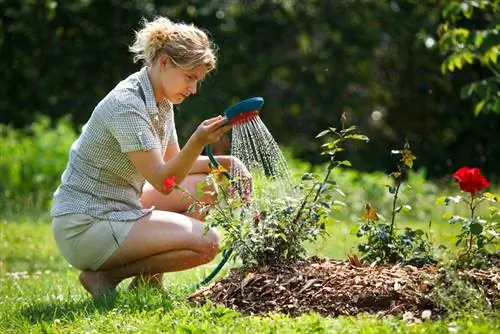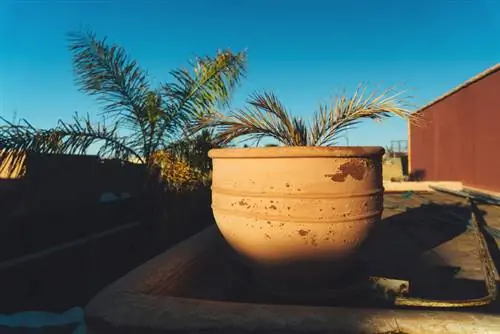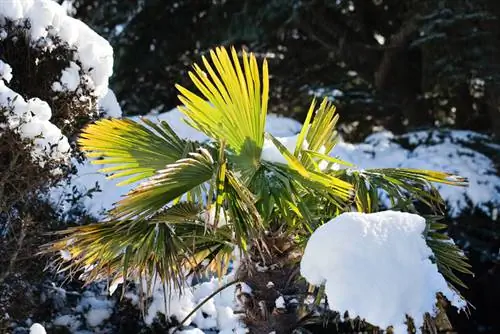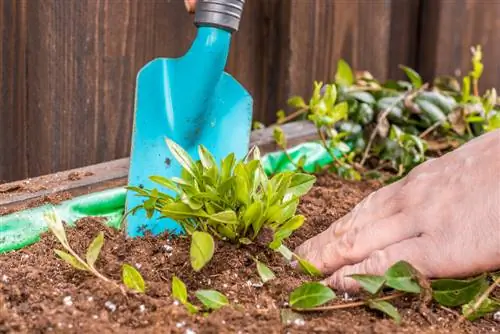- Author admin [email protected].
- Public 2023-12-16 16:46.
- Last modified 2025-01-23 11:20.
Palm trees enchant green spaces, winter gardens or the house with their southern flair. The plants, popularly known as the “princes of the plant kingdom,” require good living conditions and a little attention in order to thrive as desired. This is not complicated, there are just a few basic things to consider.
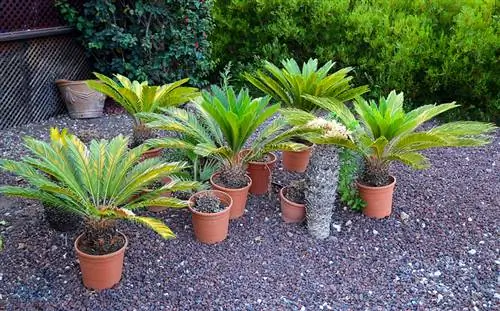
How do you properly care for palm trees?
To properly care for palm trees, you should ensure there is enough water without causing waterlogging, spray the plant regularly, fertilize appropriately, repot if necessary and treat pests or diseases. Overwintering and choice of location are also important for the well-being of the palm.
What water requirements do palm trees need?
Large plants in particular surprise with their thirst in the warm summer months. During this time, watering needs to be done relatively frequently. At the same time, all palm plants react very sensitively to waterlogging. Please adhere to the following points when watering:
- Water whenever the top few inches of soil feel dry.
- During high temperatures, daily watering may be necessary.
- In the transitional period, it is sufficient to water once a week.
- Immediately tip away any excess liquid in the coaster.
Spray palm trees regularly
The plants thrive significantly better in moderate humidity. If the air is too dry, the tips of the leaves turn brown and become unsightly. Therefore, spray the attractive fronds daily with room temperature, lime-free water. Water containing lime should not be used as it leaves very unsightly stains on the leaves after drying.
How to fertilize?
During the growing season, the plants require a lot of energy and must be fertilized regularly. How much special fertilizer you give depends on the variety. For slow-growing palm plants, give at most half the concentration stated on the packaging; fast-growing palms receive exactly the recommended amount of fertilizer.
How to cut?
In most cases, palm trees do not need to be trimmed. However, over time, the lowest leaves of almost all specimens become brown and unsightly. Wait until they have dried up to the trunk and then carefully pluck off the fronds.
Repotting
Palm trees only need to be repotted every three to four years. Only when the substrate is completely covered with roots does it need a new pot. When moving, proceed as follows:
- The new planter should be no more than two sizes larger than the previous one.
- Since palm trees are usually top-heavy, heavy, tall clay pots are recommended.
- Take the plant out of the old bucket very carefully. The thick, fleshy roots are quite sensitive and must not be damaged.
- First place a shard over the water drainage hole and then add a drainage layer of expanded clay into the vessel.
- Place a thin layer of special soil for palm trees or a mixture of compost soil enriched with leaf mold, peat, sharp sand or lava granules.
- Insert palm tree.
- Fill with substrate up to a few centimeters below the edge of the pot.
- Water well.
Which fungi or pests are threatening?
Palm trees are quite robust. If you care for them properly, the plants are rarely attacked by insect pests or diseases.
Mushrooms
A black coating on the fronds indicates sooty mold, which often forms on the excrement of lice. First wash the foliage thoroughly and then treat the palm with an aphid treatment.
Phoenix smut fungi show themselves through nodules on the palm fronds. If the infestation is minor, it is sufficient to cut off the affected leaves and dispose of them in household waste. If the infection is severe, the plant must be treated with a special fungicide.
Pests
If spider mites have settled on the palm tree, the fronds turn yellowish or white. There are fine webs on the underside of the leaves, which often only become visible when sprayed with water. Increase the humidity as a preventive measure. In the event of an infestation, only treatment with suitable sprays can help.
White wooly coatings on the fronds indicate mealybugs or mealybugs. Here too, only spraying with a chemical agent helps.
You can recognize thrips or aphids by their bright leaf spots. Shower the plant with a sharp jet to remove the animals and then spray with an insecticide.
Brightly colored fronds can indicate scale insects, which are usually found on the underside of the leaves. The relatively large pests are easy to collect. Alternatively, treat here with a pesticide.
The palm tree in winter
Winter-proof palm trees planted in the garden receive winter protection made of fleece and a thick mulch of leaves and brushwood, which protects the roots from severe frosts.
Bucket palms that were left outdoors during the summer must overwinter in suitable quarters. The winter garden or a slightly heated greenhouse is ideal. A cellar room with an even temperature and not too dark or a frost-free garage are also suitable. The palm tree is watered only slightly and not fertilized. The substrate must only be slightly moist and never wet, otherwise there is a risk of root rot.
Tip
If you care for palm trees properly, they will grow very large. Therefore, when choosing a location, make sure that the plant has enough space. Avoid windy places and those with drafts as the beautiful fronds can be severely affected.


